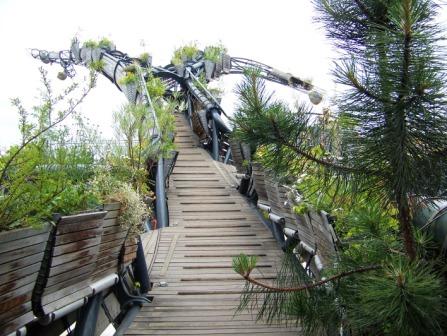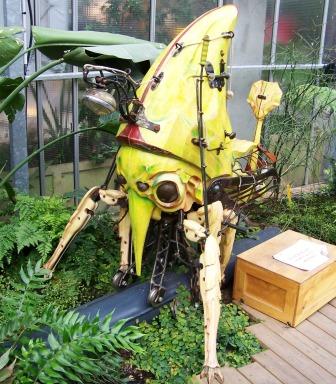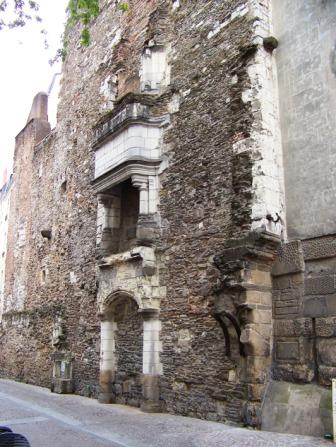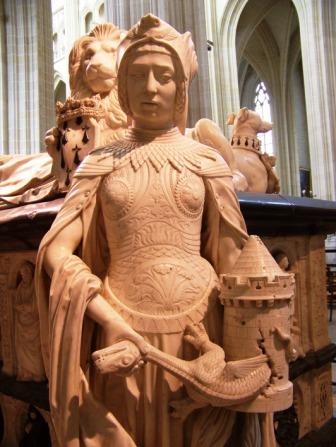Nantes
The city of Nantes is the former capital of Brittany.
Nantes
The city of Nantes is the former capital of Brittany.
A little history lesson: Brittany was an independent region throughout the Middle Ages, sometimes allied with France, sometimes with England. That independence was ended in 1488, though, when the last duke of Brittany died without sons, leaving only a daughter, Anne, to inherit. She was forced to marry the king of France, Charles VIII, to bring the region under royal French control, and when Charles died without heirs, she was also forced to marry the next king of France, Louis XII, Charles' cousin. She had no children from her first marriage, and only a daughter, Claude, from her second marriage, but she left her title as duchess of Brittany to Claude--who was also forced to marry the next king of France, Francis I, another cousin. With that last marriage, because Claude and Francis had a son who inherited both the kingdom of France and the duchy of Brittany, Brittany finally became part of France.
Okay, back to Nantes: Our first stop of the day was at the series of workshops called Les Machines de l'Île de Nantes.
We didn't know quite what to expect, but it turned out to be a fantastic place. It opened only in 2007, and was
an attempt to recreate a new purpose for Nantes' unused shipyards--and to celebrate the imagination of French
novelist Jules Verne (author of famous novels like "Journey to the Century of the Earth," "Twenty Thousand
Leagues Under the Sea," and "Around the World in Eighty Days"), who was born in Nantes in 1828.

It is housed in the buildings where ships used to be built, so there is lots of space, now busy with artists.

What are the artists doing? Making machines in the shapes of animals and birds and other creatures.
Here is a model of their latest project: a huge mechanical tree 92 feet high and 147 feet wide, stretching out over the Loire River.
A prototype of one section of the tree has been built. It is essentially a hanging garden, a walkway lined with boxes filled with plants.

Tucked away in
the branches of the tree will be a number of "rides" in the shapes
of creatures, and you will be able to slither
or flap or scuttle across from one branch to another on the backs of these
creatures. It is expected to be completed in 2014.


They were just
putting the finishing touches to a giant carousel, sadly, scheduled to open
about a month
after we were there. The carousel will have three levels, and you will ride
around on fish and other
underwater creatures on the lower levels and on birds and a sea monster on
the upper level.

The elephant was
the first major project. It carries about thiry people within its body and
atop its back, and its legs walk and its trunk sways and its ears flap as
it moves around.


What an incredible place!
The center of Nantes was also very nice--it's a big and bustling city, but with many pedestrian streets in the old town.




At one end of the old town is the castle that was the residence for the medieval dukes of Brittany.

The cathedral of Nantes was begun in 1434 in the Gothic style, but only completed in 1891.



Within the cathedral is the elaborate tomb of the last duke of Brittany, Francis II, and his wife, Margaret of Foix.

Their pillows are supported by angels (above).

At each corner
of the tomb are four figures representing the four cardinal virtues:
courage (above left, dressed as a warrior and killing a dragon), justice (above
right,
with a sword in one hand and a book showing a balance in the other), temperance
(below left, with a horse's bridle in one hand, a symbol of restraint, and
a clock
in the other, symbol of a measured life), and prudence (below right, with
a compass
in one hand, for judging the extent of one's actions, and a mirror in the
other,
for self-reflection). All of these figures are elegantly carved in white marble.

This is the last page. We had a wonderful time in France, and we hope you've enjoyed our photos!